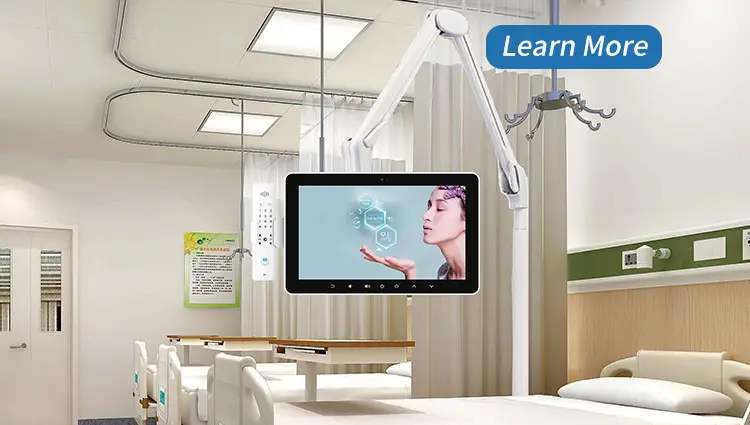The modern healthcare landscape is undergoing a profound and necessary evolution. Hospitals are no longer solely judged on the efficacy of their clinical outcomes; they are increasingly evaluated on the entire patient journey. This shift—from a purely curative approach to one centered on holistic, patient-centric care—places tremendous pressure on institutions to improve satisfaction scores (HCAHPS), drive down operational costs, and, critically, improve staff retention.
Within this dynamic environment, the patient’s room, once a purely functional space, is being reimagined as a proactive center for care management and personal well-being. The traditional bedside television, long a static source of distraction, is giving way to a far more sophisticated, interconnected device: the Hospital Bedside Infotainment System (HBIS).
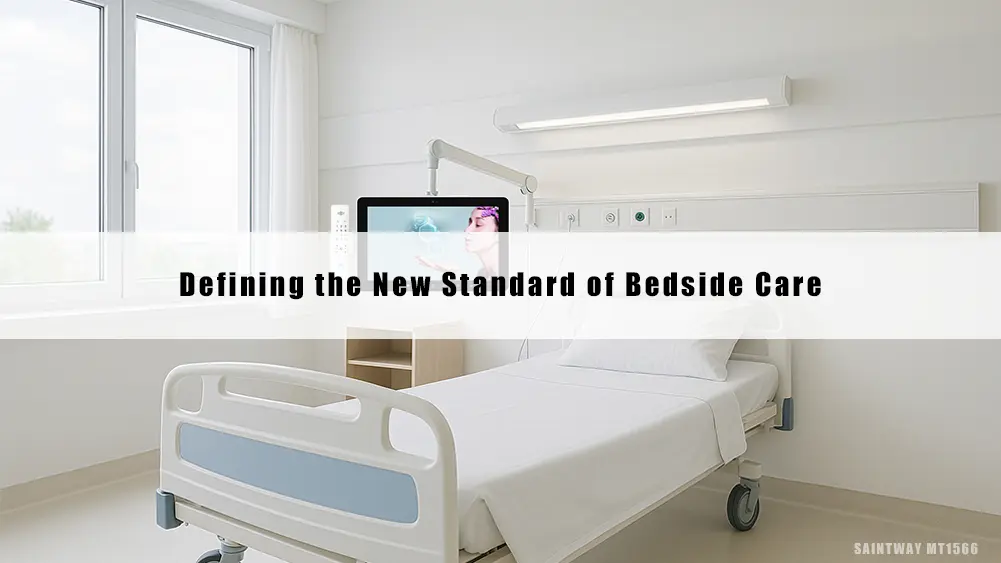
Defining the New Standard of Bedside Care
A modern HBIS is exponentially more powerful than its predecessor. It is not merely an entertainment console; it is a networked, interactive healthcare terminal. These advanced systems typically feature high-definition touchscreens mounted on articulating arms, giving patients full, ergonomic control.
Its core functions span four essential domains:
- Entertainment: On-demand access to movies, games, internet browsing, and personalized content.
- Education: Personalized video libraries, discharge instructions, and interactive health summaries.
- Communication: Secure messaging with the care team and virtual visit capabilities for family.
- Control: Digital meal ordering, environmental controls (lights, temperature), and self-service requests.
The clinical and administrative community must recognize that implementing an HBIS is not an optional amenity but a strategic investment. This technology acts as a force multiplier, addressing critical pain points for both patients and providers. It fundamentally transforms the care delivery model, significantly improving the Quadruple Aim of healthcare: better patient experience, improved population health (through education), lower costs (through efficiency), and enhanced staff satisfaction.
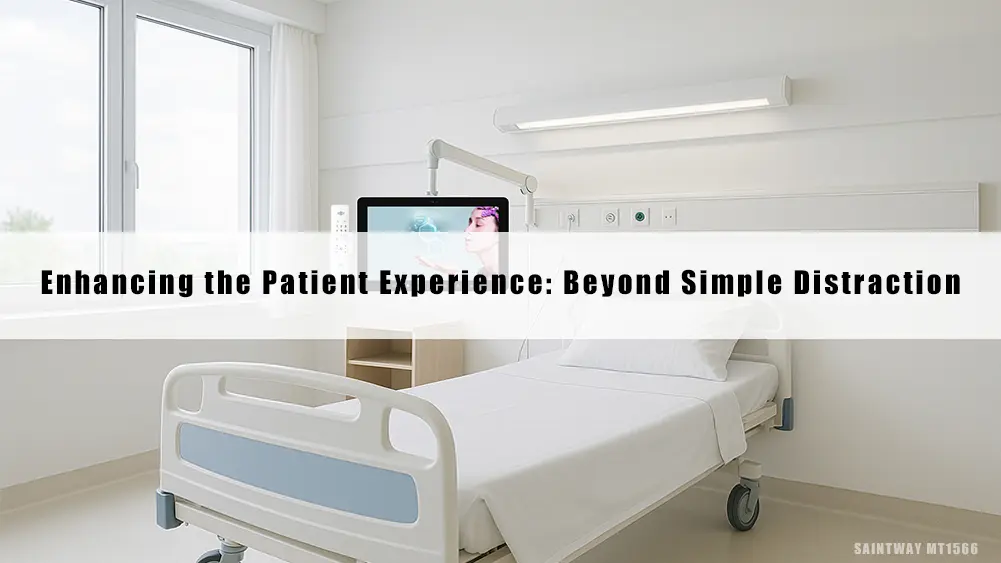
Enhancing the Patient Experience: Beyond Simple Distraction
For many, a hospital stay is synonymous with boredom, isolation, and anxiety. Lying in a bed, disconnected from their routine and often confused about their condition, patients can quickly feel disempowered. The HBIS offers an immediate, tangible solution to this psychological challenge.
The Psychological Lift and Patient Comfort
By providing a robust suite of entertainment options—from personalized music playlists and streaming services to therapeutic relaxation programs—the HBIS transforms the emotional landscape of the patient room. This focus on patient comfort and mental wellness in hospitals is critical. A distracted, less anxious patient is often a patient who requires less non-pharmacological intervention for pain management. Furthermore, the ability to maintain essential family connection through integrated video calling features (like secured tele-visiting) significantly mitigates the feeling of isolation, which has been shown to be detrimental to recovery.
Empowering the Informed Patient: Reducing Uncertainty
One of the greatest sources of patient anxiety is the lack of timely, understandable information. This is where the HBIS proves its value as a powerful educational tool, directly addressing health literacy challenges.
The system allows the clinical team to push personalized, on-demand content directly to the patient’s screen. Instead of receiving a thick binder of printed materials, the patient can view a 3D animation explaining their upcoming procedure or a video detailing the purpose and side effects of their new medication. Access to this information promotes treatment compliance and self-efficacy. By enabling patients to review educational content at their own pace, they arrive at crucial physician discussions better prepared to ask informed questions, leading to higher quality and more efficient doctor-patient interactions. This focus on empowering patients through continuous, personalized learning directly correlates with improved long-term adherence to discharge plans—a key factor in reducing costly readmissions.
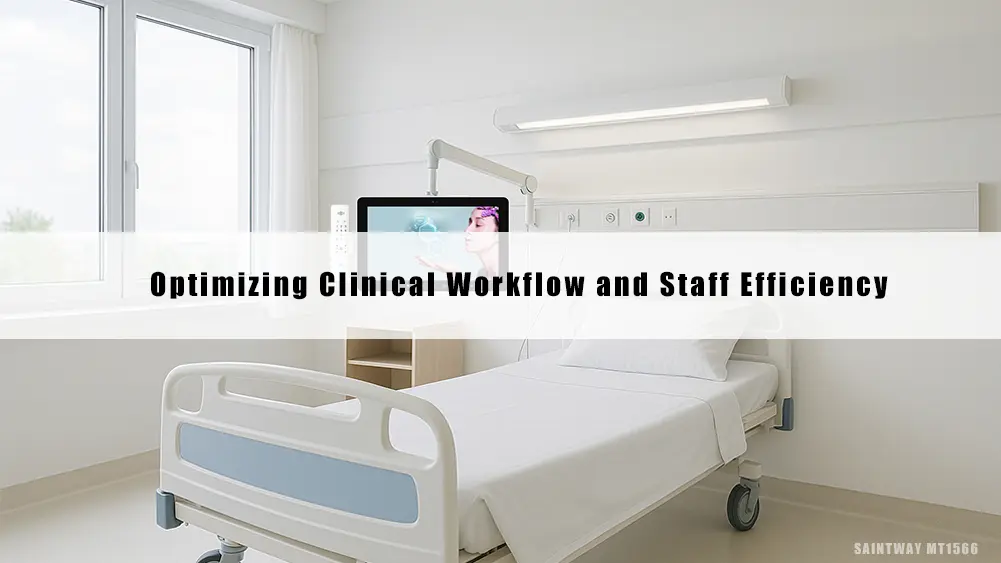
Optimizing Clinical Workflow and Staff Efficiency
The benefits of the HBIS extend far beyond the patient’s direct experience; they profoundly impact the care team’s daily operations. In an era where nursing informatics and care team optimization are critical to sustainability, the bedside system acts as a crucial digital assistant, alleviating the non-clinical workload that currently plagues nurses and contributes significantly to high rates of burnout.
A. Reducing the Non-Clinical Burden on Nursing Staff
One of the most persistent drains on a nurse’s time is the constant need to respond to non-urgent, non-clinical patient requests—questions about meal times, requests for an extra blanket, or help with operating the television. These interactions, while seemingly minor, accumulate over a shift, pulling nurses away from critical care duties.
The HBIS introduces a vital layer of patient self-service technology. Patients can use the bedside unit to digitally order meals (guided by their specific dietary restrictions), request maintenance, ask for comfort items (like a pillow or reading light), and get answers to common questions via an integrated FAQ. These requests are efficiently routed directly to the appropriate support staff (e.g., dietary or environmental services), effectively bypassing and significantly reducing the usage of the traditional nurse call bell system for non-clinical needs. Reducing nurse burnout with patient self-service technology is a direct and measurable outcome of this implementation, allowing skilled nurses to dedicate their expertise to tasks that genuinely require clinical judgment.
B. Improving Communication and Care Coordination
Effective communication is the cornerstone of patient safety and quality care. Traditional communication methods—whiteboards, paper schedules, and reliance on verbal updates—are inherently prone to error and outdated information.
The HBIS replaces the traditional magnetic or dry-erase board with a dynamic, digital whiteboard. This screen provides real-time, accurate information visible to both the patient and the care team, displaying:
- The names and photos of the assigned Nurse, Physician, and specialists for the shift.
- The day’s schedule of procedures, tests, and medication times.
- Key patient goals and discharge expectations.
Furthermore, the system facilitates a secure, internal messaging channel between the patient and their assigned care team. This capability ensures that questions are answered in a structured, logged environment, improving accountability and ensuring compliance with privacy standards. It streamlines the flow of critical information, minimizing misunderstandings that can lead to medical errors or patient distress.
C. Medication Reconciliation & Education Delivery
The transition from administering medication to patient understanding is a crucial, high-risk moment in care. The bedside unit can be programmed to display interactive checklists and educational videos specific to the medication the patient is about to receive. Before the nurse administers the drug, the patient can digitally confirm they have watched the associated educational content and understand the medication’s purpose, expected effects, and potential side effects. This dual-confirmation process enhances safety, documents patient comprehension, and reinforces the principles of informed consent and treatment adherence.
The Compelling Financial and Operational ROI
The implementation of a sophisticated technology system, whether in a new build or a renovation, involves significant capital expenditure. Hospital administrators, therefore, require a clear and compelling return on investment (ROI). The HBIS delivers financial value through increased revenue potential, hard operational cost savings, and intangible yet critical improvements in market competitiveness.
A. Increased Reimbursement and Market Competitiveness
In the era of value-based care, reimbursement from organizations like the Centers for Medicare & Medicaid Services (CMS) is inextricably linked to patient satisfaction metrics, most notably the HCAHPS scores. As demonstrated in Section II, the HBIS directly and positively impacts the key HCAHPS domains: “Responsiveness of Hospital Staff,” “Communication with Nurses/Doctors,” and “Pain Management.”
ROI of bedside infotainment systems for hospitals is realized when higher HCAHPS scores translate into access to the highest tiers of value-based reimbursement. By transforming the patient experience from one of passive waiting to one of active engagement, the HBIS elevates the hospital’s reputation, making it a preferred provider in a competitive market. This market perception advantage can significantly increase patient volume and referrals.
B. Operational Cost Reduction
The HBIS offers several avenues for hard cost savings by digitizing processes:
- Reduced Printing Costs: Eliminating the need to print thousands of paper menus, educational packets, hospital guides, and patient survey forms saves substantial costs related to paper, toner, and administrative time.
- Lower Readmission Rates: As the system boosts health literacy and ensures better compliance with discharge instructions, it contributes to fewer costly readmissions, particularly within the sensitive 30-day window, resulting in significant financial penalties avoidance.
- Reduced Turnover Costs: The inverse relationship between nurse burnout (alleviated by LTW 4) and staff retention is a major financial factor. Replacing a single nurse can cost a hospital tens of thousands of dollars in recruitment, training, and temporary staffing fees. By improving the workflow and job satisfaction, the HBIS indirectly contributes to a more stable and financially predictable workforce.
C. Enhanced Revenue Streams (Optional Value-Added Services)
Some HBIS platforms are designed to allow for optional, revenue-generating features. This might include offering premium subscription content packages (e.g., high-definition sports channels or niche entertainment) or facilitating paid, virtual follow-up appointments with specialists via secure telehealth integration directly through the bedside unit. This capability positions the HBIS not just as a cost center, but as a flexible platform for future digital health initiatives.
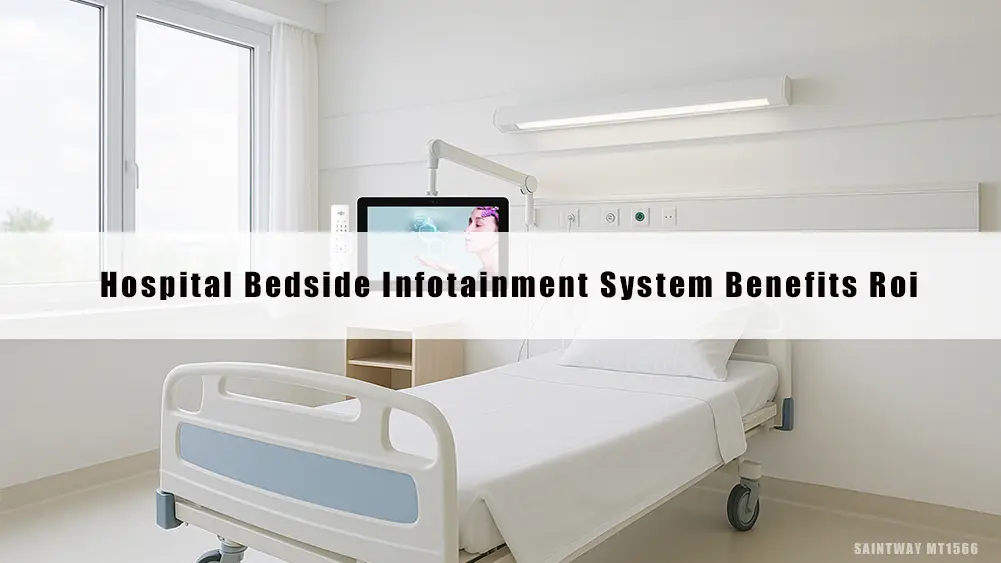
Implementation Considerations and Best Practices
The successful deployment of an HBIS is fundamentally dependent on careful planning and execution that adheres to stringent healthcare technology standards. A poorly executed implementation can undermine the technology’s effectiveness and create new complications for staff.
A. Integration with Existing EHR/HIS
The bedrock of a functional HBIS is seamless healthcare interoperability. The system must maintain a stable, bidirectional interface with the hospital’s Electronic Health Record (EHR) system (e.g., Epic, Cerner). Data must flow securely and automatically: patient identity and clinical information from the EHR to the bedside unit, and self-reported patient feedback (e.g., pain levels, requests) from the unit back into the EHR. This integration typically requires adherence to standards like HL7 and robust testing to ensure accuracy and reliability. Any failure in this data flow renders the system a mere distraction rather than a clinical tool.
B. Security and Compliance
Data security is non-negotiable. Because the HBIS handles Protected Health Information (PHI) and may integrate with the hospital’s core IT infrastructure, it must adhere strictly to privacy regulations, including HIPAA in the US or GDPR in Europe.
Secure patient data management on hospital bedside devices requires several critical security measures:
- Robust Encryption: All data transmitted to and from the device must be heavily encrypted.
- Strict Access Control: The system must only display information relevant to the currently logged-in patient and must automatically wipe all PHI upon patient discharge or device reset.
- Data Compartmentalization: Clinical and non-clinical data streams must be kept separate and secure, and the system must be firewalled off from the hospital’s most sensitive core network components.
C. User Experience (UX) Design and Accessibility
The system is only valuable if patients and staff use it effectively. Therefore, the interface must prioritize intuitive User Experience (UX) Design. It must be simple, using clear iconography and minimal steps to perform key actions (like calling the nurse or ordering a meal). Crucially, the system must meet high accessibility standards, accounting for patients who may have visual impairments, limited mobility, or low technological proficiency. Best practices for implementing hospital bedside technology always emphasize comprehensive training for staff and a simplified, “plug-and-play” experience for patients.
D. Phased Rollout and Staff Training
A successful HBIS implementation should follow a measured, phased rollout, beginning with a small pilot program on one or two units. This allows the IT and clinical teams to identify and resolve integration bugs, user interface issues, and workflow friction points before a full hospital-wide launch. Dedicated, mandatory staff training is essential; nurses and support teams must understand how the technology works and, more importantly, why it is beneficial to their daily tasks, ensuring enthusiastic adoption.
Conclusion
The modern Hospital Bedside Infotainment System represents a pivotal evolution in healthcare technology. It is the physical manifestation of the shift toward patient-centric care and a critical component in achieving true operational excellence.
By simultaneously addressing the patient’s need for comfort, education, and connection, while providing clinical teams with the tools to reduce non-clinical interruptions and streamline workflows, the HBIS delivers concrete, measurable benefits across the entire healthcare ecosystem. It is the essential bridge connecting clinical excellence with the patient’s personal journey to recovery. Investing in this technology is not merely an upgrade; it is a strategic decision that fundamentally improves the Quadruple Aim of healthcare—ultimately leading to better outcomes, higher satisfaction, and sustainable financial health for the institution.

